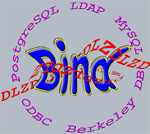The LDAP driver is built to be flexible and work with various schemas. Unfortunately, due to the nature of LDAP itself, this driver is not as flexible as the SQL based drivers. DLZ comes with an LDAP schema which was designed for DNS data. You may use it or design your own. The DLZ schema is used for the example configuration detailed below.
LDAP data is usually arranged in a tree structure. The DLZ schema easily supports two tree structures. Both hold the exact same data, but the first (tree structure 1) provides a bit more organization for human users. The diagrams below demonstrate the two tree structures. This configuration example will use tree structure 1.

|

|

|
# server suffix - o=bind-dlz dn: o=bind-dlz objectclass: organization o: bind-dlz dn: ou=dns,o=bind-dlz objectclass: organizationalUnit ou: dns dn: dlzZoneName=example.com,ou=dns,o=bind-dlz objectclass: dlzZone dlzZoneName: example.com dn: dlzHostName=@,dlzZoneName=example.com,ou=dns,o=bind-dlz objectclass: dlzHost dlzHostName: @ dn: dlzHostName=www,dlzZoneName=example.com,ou=dns,o=bind-dlz objectclass: dlzHost dlzHostName: www dn: dlzHostName=mail,dlzZoneName=example.com,ou=dns,o=bind-dlz objectclass: dlzHost dlzHostName: mail dn: dlzHostName=backup,dlzZoneName=example.com,ou=dns,o=bind-dlz objectclass: dlzHost dlzHostName: backup dn: dlzHostName=ns1,dlzZoneName=example.com,ou=dns,o=bind-dlz objectclass: dlzHost dlzHostName: ns1 dn: dlzHostName=ns2,dlzZoneName=example.com,ou=dns,o=bind-dlz objectclass: dlzHost dlzHostName: ns2 dn: dlzHostName=~,dlzZoneName=example.com,ou=dns,o=bind-dlz objectclass: dlzHost dlzHostName: ~ dn: dlzRecordID=1,dlzHostName=@,dlzZoneName=example.com,ou=dns,o=bind-dlz objectclass: dlzGenericRecord dlzRecordID: 1 dlzHostName: @ dlzType: txt dlzData: "this is a text record" dlzTTL: 10 dn: dlzRecordID=2,dlzHostName=www,dlzZoneName=example.com,ou=dns,o=bind-dlz objectclass: dlzARecord dlzRecordID: 2 dlzHostName: www dlzType: a dlzIPAddr: 192.168.0.1 dlzTTL: 10 dn: dlzRecordID=3,dlzHostName=mail,dlzZoneName=example.com,ou=dns,o=bind-dlz objectclass: dlzARecord dlzRecordID: 3 dlzHostName: mail dlzType: a dlzIPAddr: 192.168.0.2 dlzTTL: 10 dn: dlzRecordID=4,dlzHostName=backup,dlzZoneName=example.com,ou=dns,o=bind-dlz objectclass: dlzARecord dlzRecordID: 4 dlzHostName: backup dlzType: a dlzIPAddr: 192.168.0.3 dlzTTL: 10 dn: dlzRecordID=5,dlzHostName=@,dlzZoneName=example.com,ou=dns,o=bind-dlz objectclass: dlzMXRecord dlzRecordID: 5 dlzHostName: @ dlzType: mx dlzData: mail dlzPreference: 20 dlzTTL: 10 dn: dlzRecordID=6,dlzHostName=@,dlzZoneName=example.com,ou=dns,o=bind-dlz objectclass: dlzMXRecord dlzRecordID: 6 dlzHostName: @ dlzType: mx dlzData: backup dlzPreference: 40 dlzTTL: 10 dn: dlzRecordID=7,dlzHostName=www,dlzZoneName=example.com,ou=dns,o=bind-dlz objectclass: dlzMXRecord dlzRecordID: 7 dlzHostName: www dlzType: mx dlzData: backup dlzPreference: 40 dlzTTL: 10 dn: dlzRecordID=8,dlzHostName=www,dlzZoneName=example.com,ou=dns,o=bind-dlz objectclass: dlzMXRecord dlzRecordID: 8 dlzHostName: www dlzType: mx dlzData: mail dlzPreference: 20 dlzTTL: 10 dn: dlzRecordID=9,dlzHostName=ns1,dlzZoneName=example.com,ou=dns,o=bind-dlz objectclass: dlzARecord dlzRecordID: 9 dlzHostName: ns1 dlzType: a dlzIPAddr: 192.168.0.4 dlzTTL: 10 dn: dlzRecordID=10,dlzHostName=ns2,dlzZoneName=example.com,ou=dns,o=bind-dlz objectclass: dlzARecord dlzRecordID: 10 dlzHostName: ns2 dlzType: a dlzIPAddr: 192.168.0.5 dlzTTL: 10 dn: dlzRecordID=11,dlzHostName=@,dlzZoneName=example.com,ou=dns,o=bind-dlz objectclass: dlzSOARecord dlzRecordID: 11 dlzHostName: @ dlzType: soa dlzSerial: 2 dlzRefresh: 2800 dlzRetry: 7200 dlzExpire: 604800 dlzMinimum: 86400 dlzAdminEmail: root.example.com. dlzPrimaryns: ns1.example.com. dlzTTL: 10 dn: dlzRecordID=12,dlzHostName=@,dlzZoneName=example.com,ou=dns,o=bind-dlz objectclass: dlzNSRecord dlzRecordID: 12 dlzHostName: @ dlzType: ns dlzData: ns1.example.com. dlzTTL: 10 dn: dlzRecordID=13,dlzHostName=@,dlzZoneName=example.com,ou=dns,o=bind-dlz objectclass: dlzNSRecord dlzRecordID: 13 dlzHostName: @ dlzType: ns dlzData: ns2 dlzTTL: 10 dn: dlzRecordID=14,dlzHostName=~,dlzZoneName=example.com,ou=dns,o=bind-dlz objectclass: dlzARecord dlzRecordID: 14 dlzHostName: ~ dlzType: a dlzIPAddr: 192.168.0.250 dlzTTL: 10 dn: dlzRecordID=15,dlzZoneName=example.com,ou=dns,o=bind-dlz objectclass: dlzXFR dlzRecordID: 15 dlzIPAddr: 127.0.0.1 |
These configuration samples have their long LDAP URL queries broken over multiple lines for readability on this page. When creating a real configuration, each LDAP URL should be on a single line with no spaces in any part of the URL.
This configuration will provide the best performance because it uses the fewest queries to obtain the information it needs. BIND is built single threaded on most UN*X based systems so one database connection (as configured here) is generally sufficient. If your system builds BIND multi-threaded by default, then you should configure your server to use more database connections. The MySQL documentation has a list of which systems are built single threaded by default.
When setting up your configuration, pay very close attention to spaces! If you include a space where you shouldn't, or don't include a space where you should, either your query will not work with the database, or BIND may not be able to properly parse the query results.
dlz "ldap zone" {
database "ldap 1
v3 simple {cn=Manager,o=bind-dlz} {secret} 192.168.2.12
ldap:///dlzZoneName=%zone%,ou=dns,o=bind-dlz???objectclass=dlzZone
ldap:///dlzHostName=%record%,dlzZoneName=%zone%,ou=dns,o=bind-dlz?
dlzTTL,dlzType,dlzPreference,dlzData,dlzIPAddr,dlzPrimaryNS,
dlzAdminEmail,dlzSerial,dlzRefresh,dlzRetry,dlzExpire,dlzMinimum?
sub?objectclass=dlzAbstractRecord";
};
|
If you must support zone transfers with DLZ, use the configuration below with this example schema. Notice the section of the configuration in GREEN. It is a pair of brackets with NO SPACES between it. It is important that the brackets have no spaces. We are telling the driver not to use an LDAP query there. If there are any spaces between the brackets, the driver will think there is an LDAP query to execute and then fail when it does try to run it.
dlz "ldap zone" {
database "ldap 1
v3 simple {cn=Manager,o=bind-dlz} {secret} 192.168.2.12
ldap:///dlzZoneName=%zone%,ou=dns,o=bind-dlz???objectclass=dlzZone
ldap:///dlzHostName=%record%,dlzZoneName=%zone%,ou=dns,o=bind-dlz?
dlzTTL,dlzType,dlzPreference,dlzData,dlzIPAddr,dlzPrimaryNS,
dlzAdminEmail,dlzSerial,dlzRefresh,dlzRetry,dlzExpire,dlzMinimum?
sub?objectclass=dlzAbstractRecord
{}
ldap:///dlzZoneName=%zone%,ou=dns,o=bind-dlz?dlzTTL,dlzType,dlzHostName,
dlzPreference,dlzData,dlzIPAddr,dlzPrimaryNS,dlzAdminEmail,
dlzSerial,dlzRefresh,dlzRetry,dlzExpire,dlzMinimum?
sub?objectclass=dlzAbstractRecord
ldap:///dlzZoneName=%zone%,ou=dns,o=bind-dlz??sub?
(&(objectclass=dlzXFR)(dlzIPAddr=%client%))";
};
|

